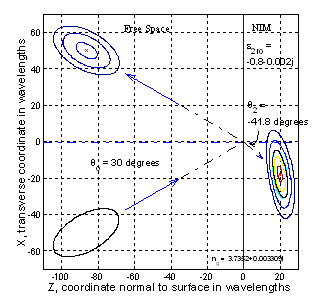|
Wave propagation and properties in negative index
media
Back to Research Main
Summary
Negative index media (NIM), also known as
left-handed media (LHM) or double negative media (DNG), have not been
found in nature. Artificial materials, called metamaterials, have been
created to demonstrate the existence of negative refraction; i.e., a
negative index of refraction. This project studies wave propagation and
other properties involved with negative index media. In a negative
index medium, the phase velocity is opposite to the direction of
propagation (the Poynting vector direction). Thus, the vector triad of
electric field, magnetic field, and k vector, which is a
right-handed triad in ordinary media, becomes a left-handed triad in
negative index media; hence, the term left-handed media was coined by
the Russian, Veselago.
Because of the left-handedness of this material,
several interesting wave properties can be exploited for applications
ranging from antenna design to optics, transmission lines, and sensors.
The figure below shows how the center of a beam wave packet refracts
negatively in accordance with Snell’s law at the interface of free space
with a NIM. However, the shape and orientation of the ellipsoidal
packet changes in a more complicated way. The possibility of
high-resolution focusing by a planar layer is another interesting
property which we have explored in considerable detail.

Wave packet propagation onto the
interface of free space and NIM
Related publications
- J. R. Thomas, and A. Ishimaru,
"Wave
Packet incident on negative index media," IEEE Transactions
on Antennas and Propagation, vol. 53, no. 5, pp. 1591-1595, May
2005.
- A. Ishimaru, S. Jaruwatanadilok,
and Y. Kuga, "Generalized
surface plasmon resonance sensors using metameterials and negative
index materials," Progress in Electromagnetics Research,
vol. 51, pp. 139-152, June 27, 2005.
- A. Ishimaru, J. R. Thomas, and
S. Jaruwatanadilok, "Electromagnetic
waves over half-space metamaterials of arbitrary permittivity and
permeability," IEEE Transactions of Antennas and Propagation,
March 2005.
- J. R. Thomas, and A. Ishimaru,
"Poynting Vector and Electric and Magnetic Energy Density as Focused
by a Slab with Relative Permittivity and Permeability Close to –1,"
URSI - APS, Albuquerque, NM, July 9-14, 2006.
- J. R. Thomas, and A. Ishimaru,
"Fields
and Poynting vector in and near the focal plane of a slab with index
of refraction close to –1 for a line source," URSI - APS,
Washington, DC, July 3-8, 2005.
- A. Ishimaru, J. R. Thomas, S.
Jaruwatanadilok, and Y. Kuga, "Source
Excitations of Backward Lateral and Surface Waves, Surface Plasmons
and Sub Wavelength Focusing in DNG Layers," URSI - APS,
Washington, DC, July 3-8, 2005.
- A. Ishimaru, S.
Jaruwatanadilok, and Y. Kuga, "Generalized
Surface Plasmon Resonance Sensor Using Metamaterials and Negative
Index Medium," URSI - APS, Monterey, CA, June 20-26,
2004.
- A. Ishimaru, and J. R. Thomas,
"Waves in layered negative index media excited by a space-time
localized source," URSI, Piza, Italy, May 23-27, 2004.
- J. R. Thomas, and A. Ishimaru,
"Transmission
properties of material with relative permittivity and permeability
close to -1," SPIE: Remote Senging and Space Technology,
Seattle, WA, August 7-11, 2002.
Sponsored by NSF

|


